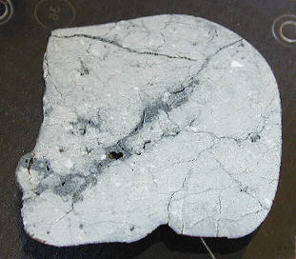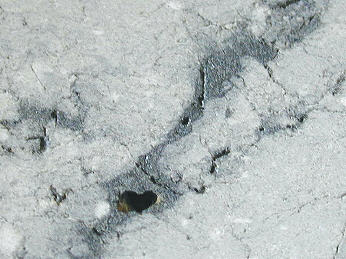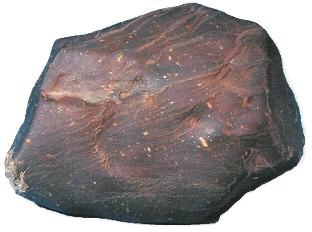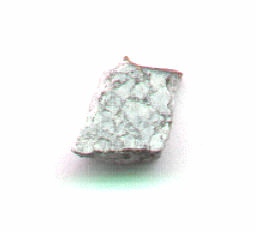NWA 482
Lunar Feldspathic BrecciaWork in Progress ... A rock that is a mechanical mixture of different minerals and/or rock fragments (clasts). A breccia may also be distinguished by the origin of its clasts: (monomict breccia: monogenetic or monolithologic, and polymict breccia: polygenetic or polylithologic). The proportions of these fragments within the unbrecciated material Click on Term to Read More
(crystalline impact-melt)
Purchased January 9, 2001
no coordinates recorded An oriented lunar meteoriteWork in progress. A solid natural object reaching a planet’s surface from interplanetary space. Solid portion of a meteoroid that survives its fall to Earth, or some other body. Meteorites are classified as stony meteorites, iron meteorites, and stony-iron meteorites. These groups are further divided according to their mineralogy and Click on Term to Read More weighing 1,015 g was originally found by a Berber nomad in late 2000 during a desert search, probably in Algeria. It was later sold in Morocco to a group of American meteorite collectors. Although much of the fusion crustMelted exterior of a meteorite that forms when it passes through Earth’s atmosphere. Friction with the air will raise a meteorite’s surface temperature upwards of 4800 K (8180 °F) and will melt (ablate) the surface minerals and flow backwards over the surface as shown in the Lafayette meteorite photograph below. Click on Term to Read More on this meteorite has been replaced by desert varnish, the interior shows little sign of terrestrial weathering. Northwest Africa 482 is a polymict, crystalline impact-melt breccia, consisting of scattered white clasts of anorthositeA phaneritic, intrusive igneous rock made with a modal composition (i.e. volume%) > 90% plagioclase feldspar of undefined composition (anorthitic to albitic, or combination thereof), and a small mafic component between 0 - 10% such as pyroxene, ilmenite, magnetite, and olivine 1. The name anorthosite is derived from the calcium-rich Click on Term to Read More within a fine-grained matrixFine grained primary and silicate-rich material in chondrites that surrounds chondrules, refractory inclusions (like CAIs), breccia clasts and other constituents. Click on Term to Read More of anorthitic plagioclaseAlso referred to as the plagioclase feldspar series. Plagioclase is a common rock-forming series of feldspar minerals containing a continuous solid solution of calcium and sodium: (Na1-x,Cax)(Alx+1,Si1-x)Si2O8 where x = 0 to 1. The Ca-rich end-member is called anorthite (pure anorthite has formula: CaAl2Si2O8) and the Na-rich end-member is albite Click on Term to Read More (An96.3), olivineGroup of silicate minerals, (Mg,Fe)2SiO4, with the compositional endpoints of forsterite (Mg2SiO4) and fayalite (Fe2SiO4). Olivine is commonly found in all chondrites within both the matrix and chondrules, achondrites including most primitive achondrites and some evolved achondrites, in pallasites as large yellow-green crystals (brown when terrestrialized), in the silicate portion Click on Term to Read More, pigeoniteLow-Ca clinopyroxene, (Ca,Mg,Fe)SiO3, found as a major mineral in eucrites and shergottites. In order to be considered pigeonite, the clinopyroxene must contain 5 to 20 mol % of calcium (Wo5 - 20). Chondrites of petrologic types 4 and below contain significant low-Ca clinopyroxene. During metamorphism to higher temperatures, all existing, and augiteHigh-Ca clinopyroxene, (Ca,Mg,Fe)SiO3, that occurs in many igneous rocks, particularly those of basaltic composition. In order to be considered augite, the clinopyroxene must contain 20 to 45 mol % of calcium (Wo20 - 45). An important and unique Martian meteorite is NWA 8159, that has been classified as an augite basalt. Click on Term to Read More, with rare troiliteBrass colored non-magnetic mineral of iron sulfide, FeS, found in a variety of meteorites. Click on Term to Read More, FeNi-metal (Ni-rich), ilmeniteTi-Fe oxide, TiFeO3, found in achondrites, lunar mare basalts, and shergottites. Ilmenite forms as a primary mineral in mafic igneous rocks. It crystallizes relatively early out of a magma before most of the other minerals, and as a result, the heavier crystals of ilmenite precipitate to the bottom of the magma Click on Term to Read More, and whitlockite. Besides anorthosite clasts, other clastA mineral or rock fragment embedded in another rock. Click on Term to Read More types that are present include troctoliteTroctolite is an intrusive igneous rock consisting of plagioclase feldspar and olivine. It is a member of gabbroic rocks family. It is compositionally similar to gabbro. The main difference is that it does not contain pyroxene or contains very little while it is a major mineral in gabbro. It can Click on Term to Read More, anorthositic troctolite, troctoliticTroctolite is an intrusive igneous rock consisting of plagioclase feldspar and olivine. It is a member of gabbroic rocks family. It is compositionally similar to gabbro. The main difference is that it does not contain pyroxene or contains very little while it is a major mineral in gabbro. It can Click on Term to Read More anorthosite, and pleonaste spinelMg-Al oxide, MgAl2O4, found in CAIs.. No KREEPLunar igneous rock rich in potassium (K), rare-earth elements (REE), phosphorus (P), thorium, and other incompatible elements. These elements are not incorporated into common rock-forming minerals during magma crystallization, and become enriched in the residual magma and the rocks that ultimately crystallize from it. Click on Term to Read More, regolithMixture of unconsolidated rocky fragments, soil, dust and other fine granular particles blanketing the surface of a body lacking an atmosphere. Regolith is the product of "gardening" by repeated meteorite impacts, and thermal processes (such as repeated heating and cooling cycles). Click on Term to Read More, Mg-suite, or mareBroad low plains surrounded by basin-forming mountains, originally thought to be a sea (pl. maria). This term is applied to the basalt-filled impact basins common on the face of the Moon visible from Earth. Click on Term to Read More components have been observed (Daubar et al., 2002), and thus a lunar far side origin is considered more favorable.

Image credit: A. Calzada-Diaz et al.
MeteoriticsScience involved in the study of meteorites and related materials. Meteoritics are closely connected to cosmochemistry, mineralogy and geochemistry. A scientist that specializes in meteoritics is called a meteoriticist. Click on Term to Read More & Planetary Science, vol. 50, p. 222 (2015) Noble gasElement occurring in the right-most column of the periodic table; also called "inert" gases. In these gases, the outer electron shell is completely filled, making them very unreactive. Click on Term to Read More studies indicate that NWA 482 records the longest residence in the lunar regolith observed to date—2.07 (±0.42) b.y—which occurred at a depth of >2.8 m (>500 g/cm² [shielding depth] divided by 1.8 g/cm³ [ave. regolith density]) (Lorenzetti et al., 2005). Northwest Africa 482 has a cosmic-ray exposure ageTime interval that a meteoroid was an independent body in space. In other words, the time between when a meteoroid was broken off its parent body and its arrival on Earth as a meteorite - also known simply as the "exposure age." It can be estimated from the observed effects Click on Term to Read More of 280 t.y., and it arrived on Earth 8.6 (±1.3) t.y. ago (Nishiizumi, 2003). According to Nishiizumi and Caffee (2010), this relatively long Moon–Earth transitWhen a small celestial body moves in front of a much larger one (as when Mercury or Venus appears in silhouette against the solar disk or when a satellite passes in front of Jupiter or Saturn). The shadow of a satellite may also transit the disk of its primary. time would be consistent with a launch from a depth of >5.6 m. They determined that shallower launches from depths of <1–4.7 m correspond to the shortest transit times of <0.1 m.y. Through studies of cosmogenic nuclides, its pre-atmospheric diameter was calculated to be ~11–14 cm, while the presence of 26Al is indicative of relatively low ablationGradual removal of the successive surface layers of a material through various processes. • The gradual removal and loss of meteoritic material by heating and vaporization as the meteoroid experiences frictional melting during its passage through the atmosphere. The resulting plasma ablates the meteor and, in cases where a meteor Click on Term to Read More, removing 1–1.5 cm from its surface. The specimen of NWA 482 pictured above is a 0.29 g partial slice displaying intricate microbrecciation. The top photo below shows the slice from which the above specimen was removed, while the bottom photo below shows a close-up of the large shock vein within the slice.


Photos courtesy of Anne Black—Impactika Meteorites The photos below show the complete oriented main massLargest fragment of a meteorite, typically at the time of recovery. Meteorites are commonly cut, sliced or sometimes broken thus reducing the size of the main mass and the resulting largest specimen is called the "largest known mass". Click on Term to Read More exhibiting flow lines in the thin remnant crustOutermost layer of a differentiated planet, asteroid or moon, usually consisting of silicate rock and extending no more than 10s of km from the surface. The term is also applied to icy bodies, in which case it is composed of ices, frozen gases, and accumulated meteoritic material. On Earth, the Click on Term to Read More or weathering rind. On the right is what might be the most beautiful photo taken of this awesome lunaite, showing a large cut face. A sizable portion of this rare meteorite has been donated for scientific study.


Photos courtesy of Jim Strope—darksideofthemoon.com







